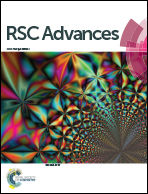Low-cost and high-performance of a vertically grown 3D Ni–Fe layered double hydroxide/graphene aerogel supercapacitor electrode material†
Abstract
Developing low cost, highly efficient, stable and earth-abundant electrode materials for supercapacitors is critical for energy storage devices. In this work, a two-dimensional (2D) nickel-iron layered double hydroxide (Ni–Fe LDH) hybrid with 2D graphene was constructed into a three-dimensional (3D) aerogel by a facile one-step hydrothermal process assisted by freeze-drying treatment. Compared with the 2D structure, the 3D hybrid aerogel shows several advantages, including a unique porous framework, a multidimensional electron transport pathway and excellent electrical conductivity. When used as a supercapacitor electrode, benefiting from the above characteristics, the Ni–Fe LDH/graphene hybrid aerogel (Ni–Fe LDH/GHA) displays a high capacitance of 1196 F g−1 at 1 A g−1 and outstanding cycling stability with a capacitance retention of 80% after 2000 cycles. Furthermore, an asymmetric supercapacitor device with Ni–Fe LDH/GHA and active carbon as the positive and negative electrodes, respectively, achieved an energy density of 17.6 W h kg−1 at a power density of 650 W kg−1 and excellent long-term cycle stability (a specific capacitance of 91 F g−1 at 1 A g−1 after 3500 cycles with 87.2% retention). This work demonstrates that low cost, high performance Ni–Fe LDH/GHA has great potential for practical applications as a positive electrode in supercapacitors.


 Please wait while we load your content...
Please wait while we load your content...